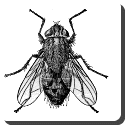 Fly — Flies are insects of the Order Diptera (Greek: di = two, and pteron = wing), possessing a single pair of wings on the mesothorax and a pair of halteres, derived from the hind wings, on the metathorax. The common housefly is a true fly and is one of the most widely distributed animals.
Fly — Flies are insects of the Order Diptera (Greek: di = two, and pteron = wing), possessing a single pair of wings on the mesothorax and a pair of halteres, derived from the hind wings, on the metathorax. The common housefly is a true fly and is one of the most widely distributed animals.
The presence of a single pair of wings distinguishes true flies from other insects with “fly” in their name, such as mayflies, dragonflies, damselflies, stoneflies, whitefly, fireflies, alderflies, dobsonflies, snakeflies, sawflies, caddisflies, butterflies or scorpionflies. Some true flies have become secondarily wingless, especially in the superfamily Hippoboscoidea, or among those that are inquilines in social insect colonies.
It is a large order, containing an estimated 240,000 species of mosquitoes, gnats, midges and others, although under half of these (about 120,000 species) have been described . It is one of the major insect orders both in terms of ecological and human (medical and economic) importance. The Diptera, in particular the mosquitoes (Culicidae), are of great importance as disease transmitters, acting as vectors for malaria, dengue, West Nile virus, yellow fever and other infectious diseases.
Diptera are a diverse order with an enormous range of ecological roles. Every type of trophic level pattern can be seen in the Diptera. Dipteran predators include the robber flies (Asilidae). A variety of herbivores can be found in the Diptera, such as the economically important fruit flies (Tephritidae). Flies are often parasites, including internal parasites such as the bot fly and external parasites such as the mosquito, black fly, sand fly or louse fly. Myiasis is the special term for flies infecting living tissue (such as the screw worm fly). Many flies eat dead organic matter (detritovores), plant or animal remains. This is especially common in the larval stage, seen in the filter-feeding mosquitos and black flies to the dung-feeding blow flies (Calliphoridae) or the organic deposit feeding rat-tailed maggot. A number of taxa feed on blood, including horse flies and mosquitos. Flies are also important pollinators for many species of plant, and many species feed on pollen and nectar.
The basic fly life cycle is egg, larvae , pupa and adult (winged stage), called holometabolism. There is often a difference in food sources for larvae versus adult dipterans of the same species. For example, mosquito larvae live in standing water and feed on detritus while the adults feed on nectar as their energy source while females utilize blood as their energy source for egg production.
Flies rely heavily on sight for survival. The compound eyes of flies are composed of thousands of individual lenses and are very sensitive to movement. Some flies have very accurate 3D vision. A few, like Ormia ochracea, have very advanced hearing organs.
There are two generally accepted suborders of Diptera. The Nematocera are usually recognized by their elongated bodies and feathery antennae as represented by mosquitoes and crane flies. The Brachycera tend to have a more roundly proportioned body and very short antennae. A more recent classification has been proposed in which the Nematocera is split into two suborders, the Archidiptera and the Eudiptera, but this has not yet gained widespread acceptance among dipterists.
 Kids Portal For Parents India Kids Network
Kids Portal For Parents India Kids Network
